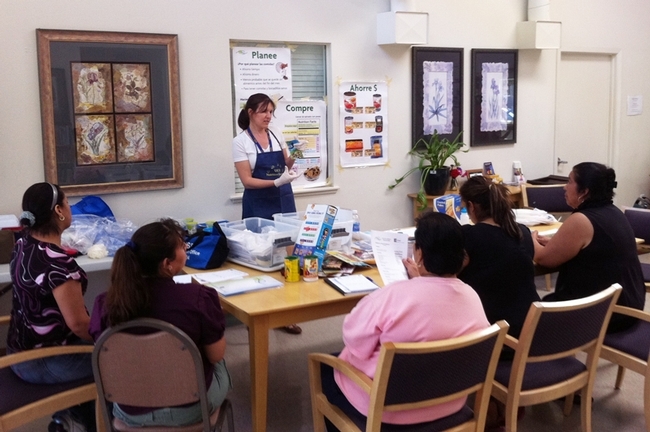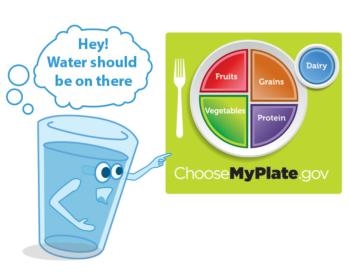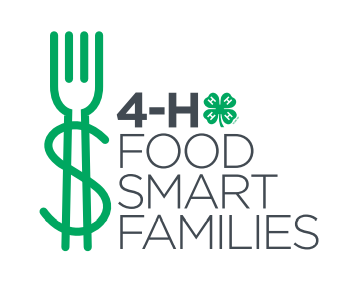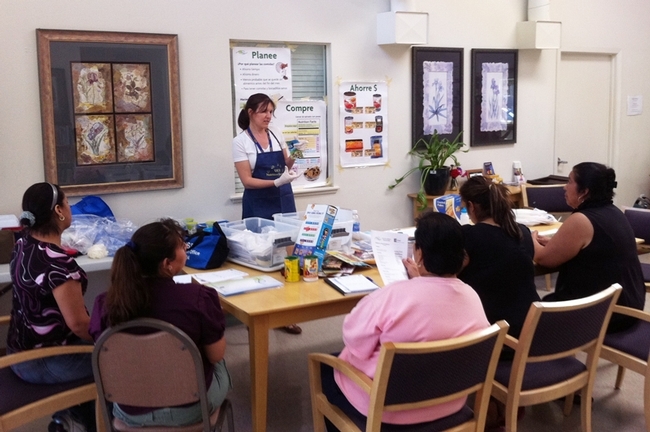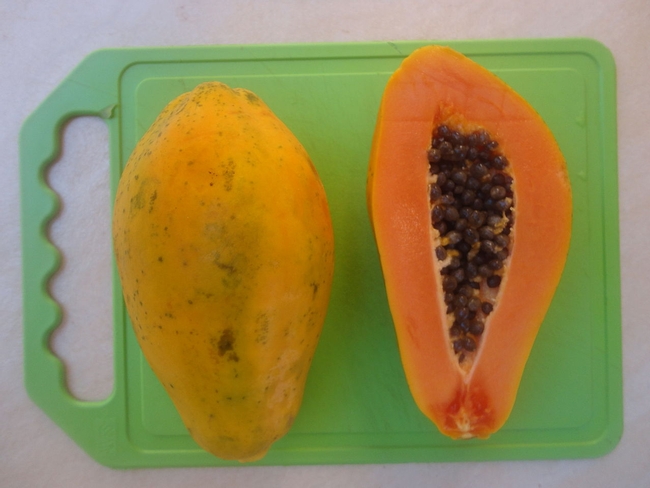UC Food and Agriculture Blogs
Food assistance and education combine to ease food insecurity
Celebrities have taken the “food stamp challenge,” trying to feed themselves on a budget equivalent to federal food benefits for the poor. Most have failed, but UC Agriculture and Natural Resources (UC ANR) has found a way to help low-income families successfully stretch their food dollars and eat healthier while receiving food assistance.
The curriculum, called “Plan, Shop, Save & Cook,” was adapted for UC CalFresh nutrition education by UC ANR Cooperative Extension academics. The program, offered in 31 California counties, is proven to help recipients of Supplemental Nutrition Assistance Program (SNAP, formerly food stamps) eat healthier and avoid running out of food by the end of the month. In California, SNAP is known as CalFresh.
The proof stems from an analysis of pre- and post-program surveys of nearly 4,000 adults who completed the four-part “Plan, Shop, Save & Cook” course. Researchers concluded that food assistance combined with nutrition and resource management education reduces food insecurity in low-income families. The results were published in the Journal of Nutrition Education and Behavior.
Plan, Shop, Save & Cook was implemented in California in 2011. From 2011 to 2013, educators in 15 counties asked participants to fill out a brief survey before and one month after completing the four-week course. The survey aimed to determine whether they were using key strategies shared in the classes, including planning meals, using a shopping list, comparing prices, reading labels, thinking about healthy choices and eating varied meals.
“We confirmed that our program helps educate and motivate participants, leading to healthier eating,” said Lucia Kaiser, UC ANR Cooperative Extension specialist based in the Department of Nutrition at UC Davis. “Increasing resource management skills – the ability shop smart and read food labels – is important to reducing food insecurity.”
Kaiser, the study's lead author, also pointed out that receiving the supplemental food benefits is a critical factor in addressing food insecurity.
“Families need SNAP and access to healthy foods in their neighborhoods,” Kaiser said. “The people in our study who were receiving food assistance were eating the best. It's really important to help eligible people get enrolled and receive food assistance.”
In the United States, 14.5 percent of households are “food insecure” – they don't have access to enough food for an active, healthy life for all household members. Among those below the income eligibility cutoff for SNAP, the percentage of food insecure households is considerably higher. Food insecurity has been associated with inadequate nutrient intake, poor mental and physical health, substandard economic performance, increased risk of chronic disease, poor psychological cognitive function and obesity.
“It may seem counter-intuitive, but research has shown that body mass index is greater in households with lower socio-economic status,” Kaiser said. “Food insecurity and obesity may coexist because the least expensive foods are often lowest in nutrients and highest in calories, and in low income areas, healthy food is not always available.”
A higher level of food assistance benefits may allow families to purchase more fruits, vegetables, whole grain products and lean dairy and protein foods. Effective education also contributes to these healthy eating habits. The Plan, Shop, Save & Cook classes are offered to small groups of adults in community settings and include skill-building activities, such as writing a menu and comparing it to dietary recommendations. Participants taste low-cost healthy foods and receive recipes to try at home.
For more information about Plan, Shop, Save & Shop contact a county UC ANR Cooperative Extension office.
An initiative to maintain and enhance healthy families and communities is part of the UC Division of Agriculture and Natural Resources Strategic Vision 2025.
NPI study: Law improves beverage environment in California childcare
In 2008 and 2012, NPI researchers conducted a survey of more than 400 randomly selected California licensed childcare facilities to look at beverages in childcare before and after California's Healthy Beverages in Child Care Act (AB 2084) took effect in January 2012. Under this law, only fat-free or low-fat (1 percent) unsweetened, plain milk for children two years of age or older is allowed, and no more than one serving per day of 100 percent juice. No sugary drinks are allowed at all. Also, drinking water must be readily available throughout the day, including at all meal, snack and play times.
NPI Director Lorrene Ritchie presented NPI's research findings on June 30 at the 8th Biennial Childhood Obesity Conference in San Diego. The NPI study found that the policy was effective at improving the beverage environment in California childcare. Provision of whole milk dropped from nearly 30 percent of childcare facilities in 2008 to less than 9 percent of facilities 2012. The provision of other beverages also improved. In 2008, 27 percent of facilities offered juice more than once a day, compared to just 20 percent in 2012. Facilities offering any sugar-sweetened beverages dropped from 7.6 percent in 2008 to 6.9 percent in 2012.
“We know the beverages children consume can put a child at risk for overweight and obesity,” said Ritchie. “The good news is that the healthy beverage standards did improve the beverage environment in California childcare. This law impacts potentially a million young children in our state.”
Despite the improved beverage environment, NPI found that only 60 percent of childcare facilities were aware of the law, and only 23 percent were in full compliance with all provisions.
“We need to do more to improve the beverage environment,” said Ritchie. “Based on our findings, we recommend that all childcare providers have access to nutrition training so that more understand and are able to comply with California's childcare beverage standards.”
The NPI study also looked at the effects of serving water at the table with meals and snacks. While this was not a provision of the California law, it is a best practice for teaching children to reach for water first for thirst. Putting water on the table did not have an impact on children's intake of milk and other foods, which was a common concern of providers caring for young children. However, the study found the law didn't make much of a difference in increasing children's water intake either.
“Simply serving water at the table with meals and snacks is not likely to interfere with intake of other healthy things,” said Ritchie. “But we don't know what would happen if water were provided in such a way as to substantively increase water intake.”
The University of California Global Food Initiative aims to put the world on a path to sustainably and nutritiously feed itself. By building on existing efforts and creating new collaborations among UC's 10 campuses, affiliated national laboratories and the Division of Agriculture and Natural Resources, the initiative will develop and export solutions for food security, health and sustainability throughout California, the United States and the world.
Now Hiring: UC IPM Editor
Come be a part of a great team! UC IPM is hiring for an Editor to work with the Urban & Community program editing and laying out educational materials. These materials include a variety of publications such as a large, frequently updated publication...
Empowering California youth through food smart families
We are what we eat. Unfortunately, we don't always make the best food choices. Sometimes it's simply a lack of will power. In communities struggling with high poverty rates, it's often the result of low incomes and limited food options. Dangerously high obesity rates, especially among youth, are a major public health concern in the United States.
The health of California youth reflects this disturbing national trend. To address the challenge of childhood obesity statewide, the California 4-H Food Smart Families program will be implemented at four sites in Fresno, Orange, Sutter-Yuba and Tulare counties this year. Additional UC partners will include the Expanded Food and Nutrition Education Program (EFNEP) and CalFresh.
Youth need to increase consumption of dark green veggies and whole grains, and decrease intake of sugar and saturated fats. The objective of California 4-H Food Smart Families is to increase knowledge and create behavior change related to nutrition, cooking, gardening, physical activity and food preparation. The program engages youth 8 to 12 years old and teens in 4-H Healthy Living programming. Youth will be directly reached through lessons delivered at after-school sites, low-resource elementary schools and organized field days at four UC Agriculture and Natural Resources Research and Extension Centers (REC): Kearney REC in Parlier, South Coast REC in Irvine, Sierra Foothill REC in Browns Valley and Lindcove REC in Exeter. The program is structured around positive youth development curricula and practices which provide an intensive engagement of underserved children, teens, families and other stakeholders. Local 4-H teens will be recruited and trained to deliver programs and assume leadership roles.
The National 4-H Council partnered with the ConAgra Food Foundation to launch the national 4-H Food Smart Families program in 2014. ConAgra sponsored funding to award grants to five states for program implementation. This year, in addition to the original five states, California and Louisiana were awarded grants as new participants. Inclusion of the UC Research and Extension Centers in the California program is a new model that organizers hope will be replicated elsewhere. Youth and families who visit the centers will witness first-hand not only how food is grown, but also the science behind it. Center specific lessons may be added to highlight the unique nature of local agriculture and natural resources and the food crops cultivated and studied at each center.
Programming at California sites will get underway this fall and will continue through the school year. Look for more exciting California 4-H Food Smart Families news in the coming months as programming and activities kick into high gear.
Author: Roberta Barton
Families use money-saving shopping tips from UC to buy healthy food
The contents of the refrigerators and cupboards of five Latino families after they participated in UC Agriculture and Natural Resources (UC ANR) nutrition training was heartening.
Most kitchens were stocked with ample fruit and vegetables, legumes and whole wheat bread. Researchers inventoried the food in the five homes before and after the training, and were able to document significant improvements attributable to UC ANR's signature nutrition education curriculum, Plan, Shop, Save & Cook.
“The classes helped families make small changes that made a difference – leading to modest, but very important savings at the end of the month. If your cupboards are bare, an extra $5 in your wallet is significant,” said Susan Algert, the nutrition, family and consumer sciences advisor for UC ANR in Santa Clara County. “The families typically turned around and spent those savings on something healthy, which is what we asked them to do.”
A report on the pilot study was published this month in the Journal of Hunger & Environmental Nutrition. The families involved were all eligible for the federal government's Supplemental Nutrition Assistance Program, which in California is called CalFresh. The educational component, administered by UC ANR Cooperative Extension, is called UC CalFresh.
“Digging through pantries is labor intensive, but revealing,” said Algert, the study's lead author. “This gives us a good idea what changes people make at home after they participate in our training.”
Typically the effectiveness of nutrition education programs are judged by asking participants to answer surveys before and after they attend classes, but errors due to attention, comprehension, memory and recording can lead to inaccurate conclusions.
“Direct observation is the gold standard and is conducted by trained researchers who travel to a subject's home and record all foods present in the home – in the refrigerator, freezer, pantry and elsewhere,” Algert said.
In the pilot evaluation, all the participants were Mexican or Mexican-American women 27 to 50 years old. A Spanish-speaking UC CalFresh educator presented three two-hour classes designed to help families stretch food dollars and increase consumption of fruits, vegetables and whole grains. The class sessions included information on the USDA's MyPlate nutrition guide, portion sizes, comparison shopping, label reading, menu planning, healthful fats, limiting sugars, cooking, and saving leftovers.
When the before-and-after food inventories were tabulated, the researchers were able to draw conclusions about the training.
One encouraging trend, Algert said, was that funds realized by money-saving tips in the curriculum were not used to buy junk food, but rather to purchase more pricey fruit like papaya and mango and slightly more expensive whole wheat bread instead of white.
“Having worked with Latinos for many years, this made sense to me,” Algert said. “They wanted fruit that was part of the family culture from Mexico.”
Four of the five families switched to whole wheat bread.
“Whole wheat bread has come down in price to $2.50 or $3 a loaf, so that is a behavior that families could change very readily,” Algert said. “One family didn't change to whole wheat because the mother said the family preferred the taste of white bread.”
Four of the five families were able to shop less often using skills they learning in the UC CalFresh training, including planning menus, making healthier recipes from scratch and making shopping lists.
One participant said, “I used to spend $100 to $150 a week on food. Now I spend the same amount but every two weeks. I'm saving a lot.”
Another participant said sticking to a shopping list helps the family stay within a budget. “Now I avoid taking my kids to 7/11 or convenience stores because the food is not healthy and it just contributes to spending more money,” the participant said. “This way, I am saving the money I can spend on healthier food.”
An initiative to maintain and enhance healthy families and communities is part of the UC Division of Agriculture and Natural Resources Strategic Vision 2025.
Author: Jeannette Warnert



